(This oven requires a separate foundation)
From the sections and orders, it can be seen that for the construction of this structure, a foundation with dimensions of 1.4x1.4 m is required, as well as the materials and components shown in the list in the ordering figure.
Depending on the layout and place of the stove in the house, the location of the pipe relative to the floor beams and the ridge of the roof, the design of the stove can be modified. For example, a fireplace portal and a hotplate can be located on adjacent or opposite walls of the stove. Drying niches - to the right or left of the firebox. But the essence of the given orders does not change from this. Just part of the rows can be laid with a shift or a turn.
Pre-prototyping is of great help in such non-standard situations, for example, using polystyrene bricks. The layout study of each row of the stove and the dressings between them allows you to avoid mistakes when laying the stove.
Oven from the side of the burners. Drying niches and a niche for firewood are clearly visible.
![]()
First test fireplace insert. The draft is good, there is no smoke.

Fitting and installing the grates is an important operation. It is necessary to ensure thermal clearances on all sides.
Is it possible to combine the incompatible or what to do if you want to have a heating stove in the house, and a fireplace and a stove bench and a sauna stove and something else, and everything in one stove? Is this possible? Yes, it is possible. But there are many “BUTs”.
- Furnaces for different purposes require different cross-sections chimneys and cannot be thoughtlessly combined into one chimney.
- Furnaces for different purposes have different degrees of heating, in this regard, there is a problem of uneven temperature distribution, which causes the furnace to crack. To avoid such a situation, it is necessary to take this factor into account during the design process.
- At the design stage, it is necessary to carefully consider the arrangement of cleaning doors to ensure free access to all canals and canal passes.
Combination ovens come in a wide variety of sizes, functionalities, and finishes. Regardless of the layout, the combination oven must be:
- Easy to handle and maintain
- Durable
- Fireproof
When building combined furnaces, you should not follow the path of complicating the design, on the contrary, you need to strive for simplicity, achieving, as it were, the coalescence of one function with another and a smooth transition of channels from one part of the furnace to another. It is possible to fold a multifunctional oven that combines the incompatible with many valves and rocker channels, but it will be very difficult to handle and maintain, which is unlikely to bring joy to those who use it.
When designing multifunctional furnaces, customers often want all gases from concurrently operating appliances to flow into one pipe. This task is very difficult to solve, especially when the furnace contains more than three combustion chambers. The way out of the situation is to fold a large section pipe with two internal channels. But such a massive pipe will take up too much space. What to do? The solution is very simple. It must be understood that the simultaneous operation of the entire furnace is impractical, therefore, a large cross-section pipe is not needed.
Let's say your stove includes three functions: a heating stove with a boiler for radiator heating, a metal bath stove connected to it, and a fireplace. It is quite clear that the sauna stove is not heated every day, and a fireplace with a heating stove will be pulled by a pipe with a cross section of 250x120mm.
Combined ovens, it is advisable to build in between rooms so that the area occupied by them is minimal, and the heat transfer is maximum. A heating stove with a fireplace, under which it is heated by a stove, is one of the most common combi stoves. Unlike a conventional stove with a fireplace, the design we are considering differs in that during the heating of the stove, the channel passing under the fireplace heats it under. This is a very good solution because the heat capacity of the fireplace is extremely small, and the heated one will give off heat for several hours.
The design is also very functional, combining a heating stove with a channel under the fireplace, a fireplace and a mini-Russian stove. With such a flow it will be beautiful and warm and satisfying. A well-designed combi-stove is capable not only of fulfilling its heating functions, but it can become a unique element of the interior in your home.
Rating: 920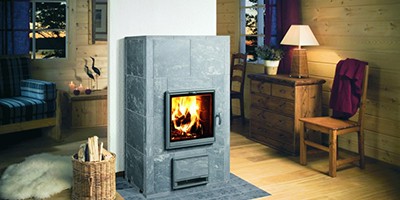
Today, houses without a heating system practically do not exist. This article focuses on modern ovens for. Each house has its own means of heating, depending on the design and size of the house or on the heating frequency.
In any case, so that the same heating means work efficiently, regardless of size and design. In the markets you can find a variety of the latest types of heating systems. Despite this, most owners prefer a simple oven for. There are many types of such ovens.
Features of modern ovens
From time immemorial, people who lived on the territory of Russia, in past centuries, massively used stoves to heat their homes. In those days, the stove was a universal piece of furniture in the house: it was used to cook food and heat the house. Even in modern homes, the stove has not lost its heating function. As a quality, furnaces are now in great demand. Various manufacturers offer a wide range of heating systems to suit all tastes.
Modern stoves for heating surpass their predecessors of the past in terms of efficiency, versatility and improved characteristics, they have a beautiful design. As an example, we can cite the most famous convection ovens, the newest inverter ovens are gaining popularity.
It is intended for heating rooms of different areas, as well as for creating an appropriate temperature in the bath room. According to their functional differences, they are divided into groups:
Heating. This type of stove is designed for space heating. It is known that modern models much more efficient than their predecessors and have a high efficiency (about 90%). This is due to the improved air supply technology. Although the principle of operation of the stove is quite simple, the stove constantly heats up cold air, giving off heat to the outside.
Cooking and heating. One of the most modern, with a very high efficiency. They are used in addition to heating, for cooking. In such an oven, the cooking device is located on top of the combustion part. In most cases, they are installed in rooms with a small area. There are models that have several burners or have been replaced with a convenient oven. Additionally, a coil can be connected to heat the water.
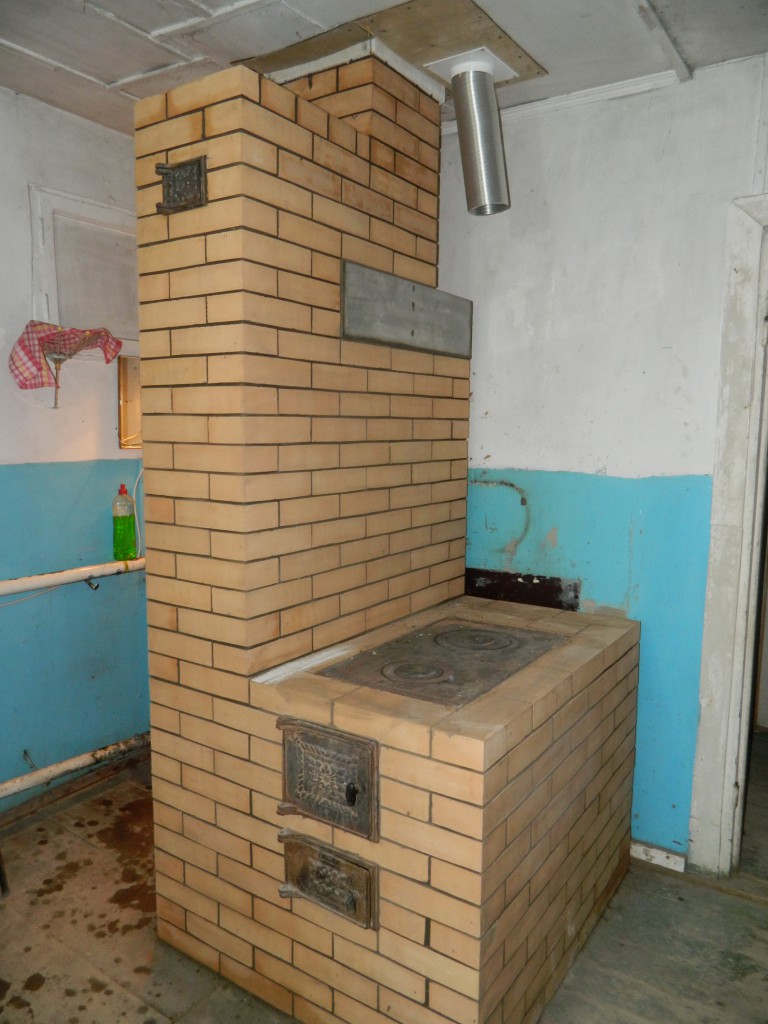
Heating stove with hob
Specialized. They are used in saunas for heating stones inside stoves.
Furnace design
By design differences, the furnaces are divided into:
- Supply air - a widespread unique stove that has advantages and disadvantages, with a simple design and. Installed in greenhouses to maintain a constant temperature. Has a pipe through which smoke is removed. Along with the smoke, heat loss is observed, this decently lowers the efficiency.
- A duct oven is a good and reliable heat source. It has a complex structure that promotes the release of cold smoke. The smoke does not enter the chimney immediately. Before that, it circulates through the internal channels, giving off the heat of the furnace. This principle of operation guarantees high efficiency.
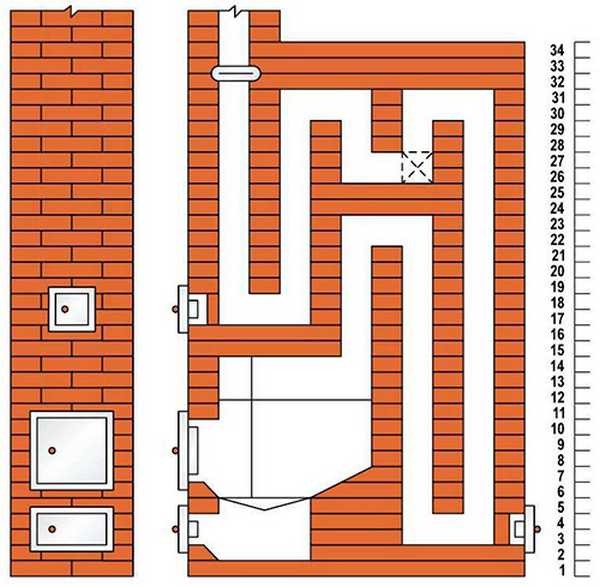
Sectional duct furnace
- Bell furnace - made on the basis of furnaces used in metallurgical plants. Now this model of the stove is used in other areas, in particular for heating a house. It gained popularity due to its simplicity of operation - the generated hot air rises upward, reaches the bell and returns back for further heat generation.
It is worth considering that when choosing a stove, it is worth paying attention to the differences. For example, a channel furnace, in order to ignite, requires a special draft, while for a bell-type furnace it is not required. The bell-type stove generates less smoke than the duct-type stove. The efficiency of a channel furnace depends on the length of the pipes that are inside it. The longer the pipes, the better.
Required building materials
Modern stoves for heating houses are made mainly of materials such as brick, cast iron, steel.
Combined brick ovens are popular due to their ease of use and have a number of advantages. It is known that the larger the oven, the more heat is generated:
- The first advantage of a brick oven is precisely its large dimensions.
- The second advantage is the ability to use various materials for kindling a fire: peat, ordinary firewood.
- The third advantage is the ability to increase the heating area when smoke is emitted. The smoke generated during combustion passes through pipes, which absorb heat, creating an additional source of heat.
- There is no definite standard for the shape, number and size of pipes.
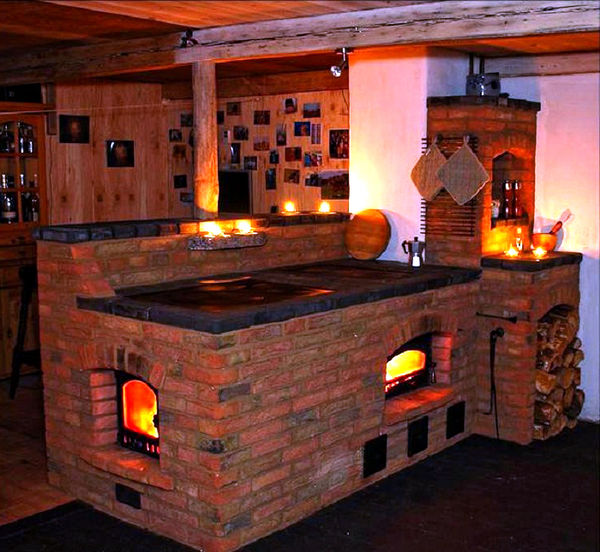
Combined brick oven
The disadvantage is that, due to its large dimensions, this heating system is impractical to use in small rooms. To build a brick kiln, it is better to use bricks that are resistant to high temperature... The brick oven heats up for a rather long time, but after the end of the work it retains heat for a long time.
Cast iron stove
An excellent means for heating, has a high efficiency. The conversion of air into warm air is carried out according to the conversion principle. The cast iron stove is also used for heating the sauna. The design of the cast-iron stove is based on special elements that provide a fairly fast ignition, long and active combustion, and high heat transfer. These properties are possessed by a Finnish stove, which has found wide application in ordinary houses. Such a furnace has a very large weight (made of cast iron), but at the same time it is small in size and quite simple to use, due to which it has become widespread.
Due to its many advantages, this material quickly filled the markets and continues to be widely used:
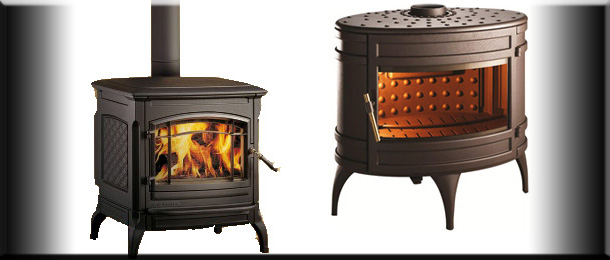
Modern metal ovens
- Firstly, they do not have large dimensions and great weight.
- Secondly, they are simple enough to install and do not require any specific experience.
- Thirdly, compared to brick ovens, they heat up quickly when they are fired up quickly.
- Fourth, they have a fairly high efficiency compared to the two previous ones. Since the metal structure, by its properties, heats up faster, respectively, it releases heat faster and as much as possible to the outside. Coal, peat, wood are used as fuel.
The steel furnace has some disadvantages due to its metal body. When using at home and in a bath, you should be careful, careless contact of the skin with the very hot body of the stove entails an injury in the form of a burn. The steel stove contributes to the formation of high humidity in rooms, which creates discomfort. Also, a steel stove, due to its small size, can distribute heat unevenly. It can be very hot in close proximity to the stove, and cold can be felt when farther away.
Your contacts in this article from 1000 rubles per month. Other mutually beneficial cooperation options are possible. Write to us at [email protected] site
Budget and expensive boilers of various modifications, operating on various fuels, have made life much easier. There is nothing easier than turning on such a boiler at the end of autumn, setting the mode and enjoying the warmth throughout the cold season. Oddly enough, but the traditional Russian stove, so troublesome to maintain, is not going to give up its positions at all. Proven for centuries, it is still the main heating device in country, country and country houses. In addition to the fact that it serves as a true decoration of the house, it allows not only to heat the room, but also to heat the bed, water and cook food. What are the types of brick stoves for the house, how they differ from each other - in our article.
Of course, the main classification of furnaces is carried out according to their purpose. There are the following main types:
- heating;
- cooking;
- combined (heating and cooking).
Heating stoves are designed, as the name suggests, to heat a home. In order for the heat to be distributed evenly throughout the house, such stoves are recommended to be installed in the wall opening, so that each end is directed to a specific room.
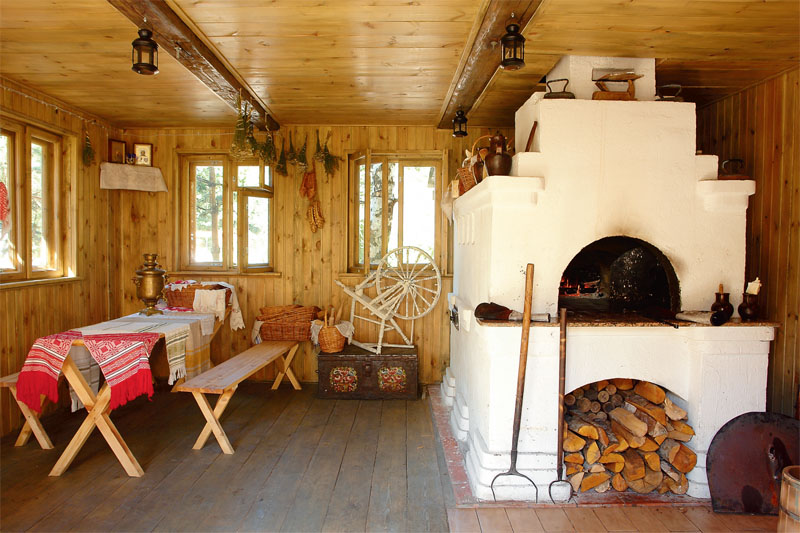
Cooking ovens simultaneously with heating allow you to cook food on a special hob, as well as bake in the oven.
There are tandoor ovens, the combustion chamber of which is treated with chamotte clay, which allows you to bake bread and flat cakes right on the walls of the oven.
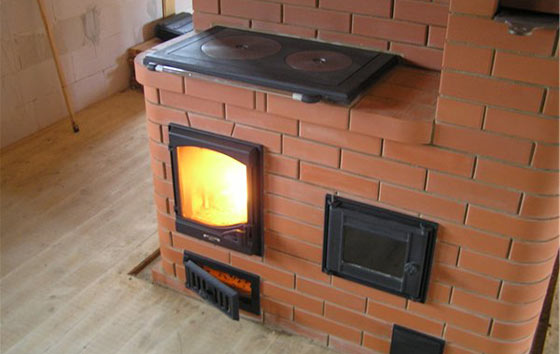
In those houses where people live permanently, the use of combined stoves with a connected water circuit is considered more appropriate. Such a stove is quite capable of providing heat even to a large house, while the stove and the oven work in parallel. If desired or necessary, combined ovens are equipped with a stove bench, a shelf for drying fruits and mushrooms, shelves for dishes, etc.
The use of a special plug allows the stove to be used exclusively for cooking or heating water in the spring-summer period.
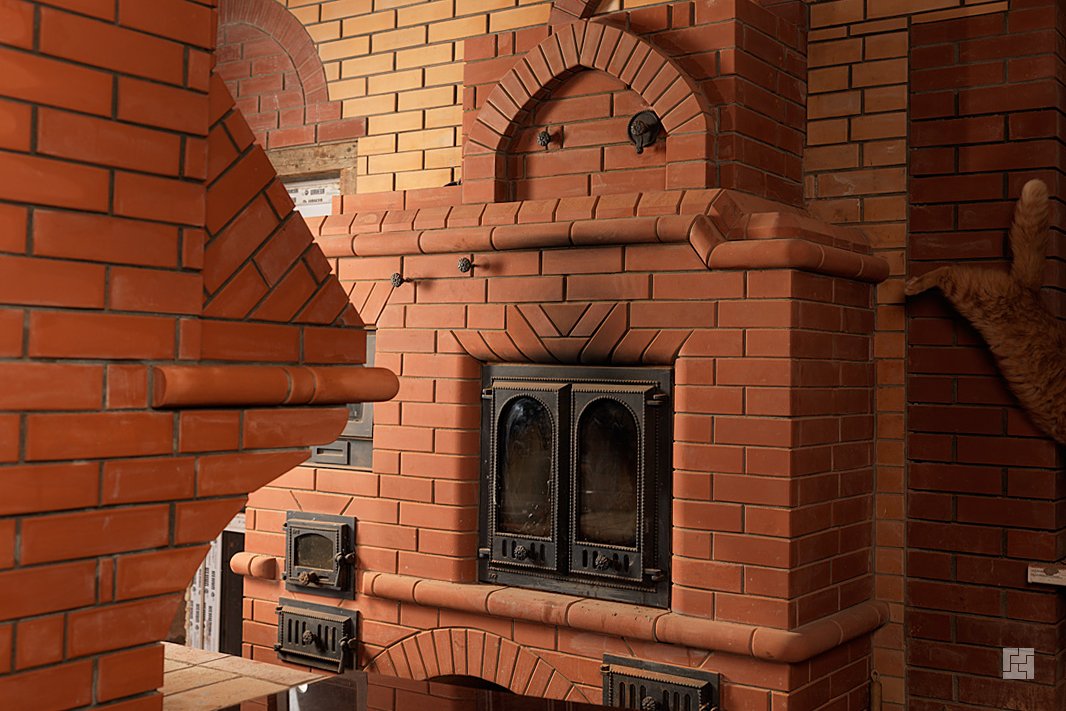
Heating stoves
The most highly specialized unit are heating stoves, although today almost no one orders them. In such ovens, only one plus can be distinguished - long-term accumulation of heat, which is realized to a lesser extent in other varieties.

Heating stoves are much heavier and more massive, in contrast to cooking and combination stoves, but they transmit heat that is much more comfortable for self-awareness. The peculiarity of the furnace lies in the thickness of the outer walls, which are usually placed in one brick - such a wall heats up more slowly, but also cools down for a very long time. When the furnace is operating, the temperature of the outer walls is 55-60 0 С.
It is very difficult to call such stoves beautiful, while they require the largest amount of bricks and painstaking work. According to the reviews of masonry masters, such ovens are rarely ordered.
Cooking ovens
This type of unit is equipped with all the arsenal necessary in the household, and at the same time is the most inexpensive option both in terms of the number of bricks and the cost of work. On average, the masonry takes about 170-180 refractory bricks, and if you provide for a heat shield, then it will even turn out to heat the room, and do it very effectively.
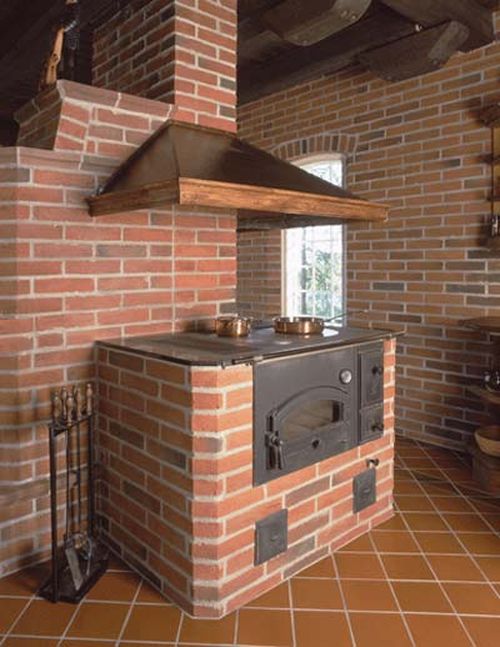
Cooking ovens are very popular among summer residents - owners of small houses. On the one hand, such a stove is cheap both in cost and in heating (you can use firewood, dead wood, etc.). On the other hand, you can cook dinner on it, and at the same time warm up the house.
Considering the fact that such ovens are relatively light and small, it is recommended to lift them on the trenches. This is a brick base, which is a masonry of 1-2 bricks to a height of 14 cm, which allows the unit to rise from the floor and provide it with natural air circulation.
The photo shows an example of a stove with a heating shield that acts as an additional heat-dissipating surface.
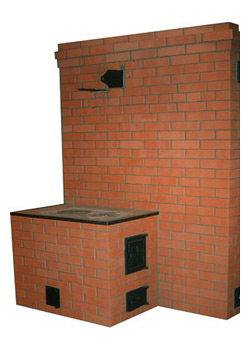
Combined ovens
It is the absolute leader of the Russian market. According to statistics, about 92% of all ovens in Russia are combined. They are used not only in the dacha sector, but also in country houses, in villages, villages and even in cities in those areas where gas is not supplied.
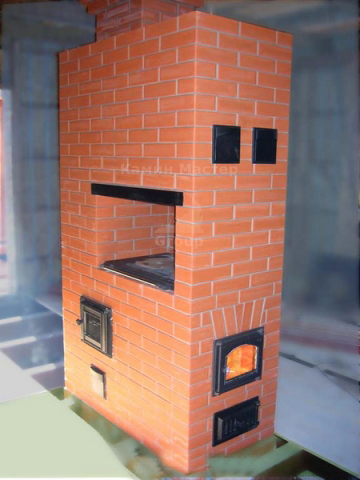
Such ovens are multifunctional, equipped with a hob (panel), an oven, a water circuit for providing hot water, and sometimes a special niche for baking bakery products. As an alternative to such ovens, when laying, they order loungers for rest, niches for drying berries and mushrooms, a sector for drying firewood, etc. The main difference from cooking ovens with a heating shield consists in a sufficiently high efficiency (60-70%), heat capacity of 3.5-4 kW, faster heating, but slow heat release.
In combination ovens, it is imperative that plugs be provided to delimit the sector of action. In the warm season, the stove can only be used for cooking and heating water, in the cold season - and for heating.
Sauna stoves
There is also a separate type of stove that is used not in the house, but in the bath. Of course in last years such units have significantly yielded under the onslaught of Finnish metal and electric ovens, but there are real connoisseurs who prefer to steam in a steam room where a real brick oven works. The main advantages include not only dry steam, which cannot be obtained from other types, but also long-term preservation of heat (up to 3 days), safety and the absence of characteristic odors not inherent in brickwork.
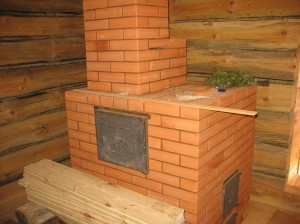
In general, the design of all sauna stoves is identical, since they all perform the same function - heating the steam room and dressing room and supplying dry steam. The difference lies in the shape, dimensions and type of the heater - open or closed.
Additional Furnace Classification Options
The main one, as mentioned earlier, is the functional purpose of the stove, which consists of three main (heating, cooking, combined) and additional (bath).
In addition, the following criteria are distinguished:
- wall heating temperature;
- burning time of one bookmark of firewood;
- the time of warming up the walls and creating a comfortable temperature inside the room;
- direction of movement of exhaust gases in the channels;
- chimney duct design;
- furnace shape - square, rapezoidal, T-shaped, etc.;
- the way of the outer part of the stove - tiles, tiles, panels, lack of decoration;
- production material - self-made refractory clay, ready-made industrial composition, bricks. The form depends on the functionality and area of the house
- equilateral;
- angle;
- trapezoidal;
- T-shaped;
- versatile architectural ensemble.
- decoration with tiles and / or ceramic and refractory tiles;
- the same gap between the rows and between the strips between the bricks - jointing;
- rubbing bricks together - old way;
- whitewashing, staining;
- lack of finishing is not recommended, as it can provoke stratification of the solution and the appearance of cracks.
Exterior finishing method
Disadvantage wood stoves for a bath, it is considered the need to constantly maintain combustion in the furnace. It takes several hours to heat a steam room. After reaching the required temperature in the bath, you will need to ensure that the temperature in the room does not drop, which is very inconvenient.
To solve this problem and increase the comfort during operation, some European manufacturers began to produce combined wood-fired and electricity-fueled sauna stoves. The advantage of stoves is in the almost complete automation of the combustion process and maintaining the required temperature in the room, and the intensity of heating the stones.
How does an electric wood stove work?
A combined electric-wood stove for a bath is a synthesis of conventional solid fuel and electrical equipment. Firewood remains the main fuel. As the temperature burns out and the temperature drops, the electric heater turns on. Two heating elements are installed on the sides of the structure. The heaters maintain the required temperature in the room and in the heater.A metal combined stove for heating a wood-electricity bath has several advantages:
- Design combination oven- the device is designed to provide maximum heat dissipation. The heating elements have a high degree of protection against electric shock, therefore, the operation of the device is absolutely safe.
- Functional features - if necessary, the stoves are equipped with a steam generator that allows you to get dry steam for a Finnish sauna.
- The principle of operation is the versatility of the oven, this is a clear advantage. If necessary, you can heat only with wood or electricity. When the voltage is connected and the necessary settings are set, the combustion is performed according to the type of a batch-type furnace.
The temperature is constantly maintained by enabling / disabling heating elements... After a power outage, a continuous oven is obtained. Heating will continue until the wood burns out.
Combo ovens are designed to be connected to a household network with 220V and three-phase voltage 380V.
Features of the operation of firewood-electricity stoves
A universal stove for a wood-electricity bath, does not require specific knowledge and skills during operation. To ensure smooth operation, the following requirements are met:- The electrical connection is carried out by a qualified electrician with the appropriate authorization and experience. Separate automatic machines, RCDs are necessarily installed and grounding is provided.
- The chimney is installed in accordance with the current standards described in SNiP and PPB. When passing through the wall and roof, fire-prevention cuts are provided.
The combo oven is installed in accordance with the manufacturer's requirements. The technical documentation provides a diagram of the connection to the power supply, the conditions for the safe operation of the heat generator are described in detail.
The combination of firewood and electricity in one stove leads to the fact that the installation of stove equipment must simultaneously meet the requirements described in the PUE, PPB and SNiP.
Pros and cons of an electric wood-burning stove in a bath
The main advantage of a universal wood-fired and electricity-fired sauna stove is its high autonomy, which increases ease of use. The stove is often stoked in the evening, leaving it to work overnight. In the morning, the steam room is completely ready to receive.The possibility of remote control is provided when the mode of operation from power supply is switched on. The activation signal will be sent through the mobile device.
Another plus is that the stove is heated with wood and electricity at the same time. In the bathhouse, during the firebox, the aroma and unique heat from the burning wood remains, while there is no need to constantly maintain the fire in the firebox.
As disadvantages, they highlight the need for a qualified electrical connection and the costs required for heating the steam room with electricity. Another drawback is the high cost of the combo stove, which exceeds the wood-burning counterpart by 40-60%.
Electric wood stoves, competitive equipment, easy to operate and maintain. The necessary overpayments for the purchase are fully paid off due to the high autonomy and safety.
Calculation of the power and temperature of a warm water floor
Heating boiler power selection calculator
Calculator for calculating the number of radiator sections
Calculator for calculating the footage of a pipe for a warm water floor
Calculation of heat loss and boiler performance
Calculation of the cost of heating depending on the type of fuel
Calculator calculating the volume of the expansion tank
Calculator for calculating heating PLEN and electric boiler
Heating costs by boiler and heat pump
Heat gun selection calculator
Selecting the power of the air conditioner








